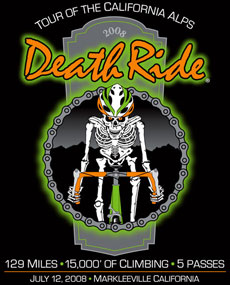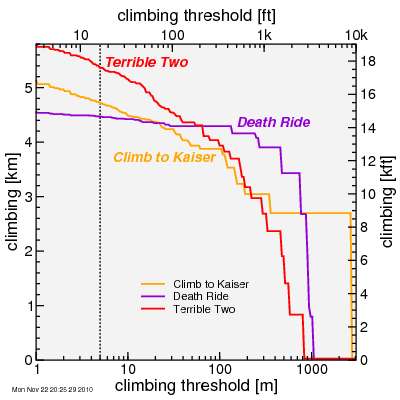Comparing the Terrible Two, Climb to Kaiser, and Death Ride
 First, a bit about the climbing algorithm. Just two paragraphs, I promise. Then on to good stuff.
First, a bit about the climbing algorithm. Just two paragraphs, I promise. Then on to good stuff.I just described an algorithm by which you can calculate total climbing from a route profile with a given "climbing threshold" designed to both eliminate small bumps which can be coasted over, but more importantly to get rid of the small altitude fluctuations which occur with "noise" in both barometric and GPS-based altimeters. I proposed that a 5 meter threshold worked well, but that there was no unique answer for what is the "true" climbing of a route.
 Well, that algorithm does work well for a relatively small climbing threshold, but when you crank the threshold up to the size of the largest hills on a ride, it can be fooled. For this post, I thus added an extra step to the process, in which peaks closer than the climbing threshold from the minimum altitude on the ride, and valleys closer than the threshold from the maximum altitude on the ride are both pruned. This may not be perfect, either, but suits the purpose of this post.
Well, that algorithm does work well for a relatively small climbing threshold, but when you crank the threshold up to the size of the largest hills on a ride, it can be fooled. For this post, I thus added an extra step to the process, in which peaks closer than the climbing threshold from the minimum altitude on the ride, and valleys closer than the threshold from the maximum altitude on the ride are both pruned. This may not be perfect, either, but suits the purpose of this post. That purpose is to compare three rides, each of which is considered a major climbing challenge for Northern California cyclists: the Death Ride, Climb to Kaiser, and the Terrible Two.
That purpose is to compare three rides, each of which is considered a major climbing challenge for Northern California cyclists: the Death Ride, Climb to Kaiser, and the Terrible Two.I've done each of these rides at least twice, and so have a special affection for each of them. They each have their own unique character, each their own brand of challenge.
Total climbing plotted versus climbing threshold provides a certain signature to the nature of a given route. So I'll do that here for these three climbs, where in each case I downloaded data from recent versions of the rides from Garmin Connect:

Impressive, all three. Each claims to have the most climbing for some range of climbing thresholds. With a low threshold, including my recommended value of 5 meters (indicated with the dotted line on the plot), the Terrible Two comes out ahead. Indeed, the Terrible Two is well names, presenting the rider with a series of extremely steep challenging climbs, most notably Skaggs Springs Road out to Highway 1, then to seal the deal, Fort Ross Road back inland. Yet none of these climbs is particularly long. The net climbing drops to zero at around 832 meters, the Gaysers.
Now consider the Climb to Kaiser. That scores second with a 5 meter threshold. But at around 25 meters if fades behind the Death Ride: Climb to Kaiser has its share of bumps. Then it fades more until it hits a wonderful plateau at near 400 meters, just enough to filter out the descent-climb at Big Creek Road. Beyond that it's clear sailing all the way out to 2695 meters, or 8840 feet, the altitude gained between the start and Kaiser Pass. This is what Kaiser is famous for: the sheer enormity of the altitude change between Clovis and the turn-around.
The Death Ride is the last of the three climbs at the 5 meter threshold. But where it excels is between approximately 70 meters and 900 meters. That's what the Death Ride is: a series of long, steady climbs followed by long, steady (and fast!) descents.
This plot compares the magnitude of climbing on the routes, but it doesn't directly say anything about grade. For that, I go to my climbing histogram, where I plot the net climbing at or above each given grade for each of the three climbs.

This plot is less ambiguous. It's clear at dishing out the steep, Terrible Two is the terrible winner. It's a solid 5% steeper at each given total climbing point than the Death Ride over much of the plot. Those are five painful percent. Climb to Kaiser delivers its dose of nasty at Big Creek. That's about as tough as it gets in this sort of ride, but it's just one climb, while Terrible Two dishes out the pain multiple times throughout its 200 miles.
Of course, Death Ride supporters will always say the altitude is the big factor there. And it is a big factor. Even though Climb to Kaiser gets higher than the Death Ride, the Death Ride stays at over 4000 foot altitude throughout, while the Climb to Kaiser just visits for part of the day. But Climb to Kaiser has terrible heat in the valley, ironically providing some of the greatest difficulty on the flattest portion of the ride. And while not up to Fresno's standards, Terrible Two is famous for its heat as well, subjecting riders to the heat for more of the course than Kaiser where it's really only the final 25 miles after riders drop from the sky.
So I stand behind the numbers: Terrible Two first, Climb to Kaiser second, and Death Ride third. All three are tough, though: it would be a terrible mistake to take the Death Ride for granted.

Comments